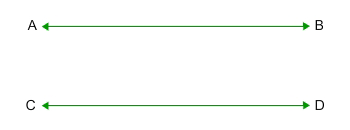Positions of Two Lines in a Plane
| Two lines that are in the same plane are called coplanar lines; otherwise they are referred to as skew lines. Two coplanar lines are either parallel or intersecting. When they have one common point, they are called intersecting lines. |
Line segments GH and EF shown below are intersecting, because they have only one common point labeled M.

If two lines have more than one intersecting point, then they coincide. That is, if two lines have more than one point in common, the two lines actually have infinite number of common points. This means that the two lines overlap and are seen as one line.
| If two lines are on the same plane and have no common points then they are called parallel lines. |
Lines AB and CD are examples of parallel lines. As you can see, they do not have any points in common. Parallel lines are usually denoted by placing the symbol " || " between their notation.
For example, parallel lines AB and CD are denoted by AB || CD.

Each of these is also a pair of parallel lines. Line YZ is parallel to line WX and line HI is parallel to line JK.
